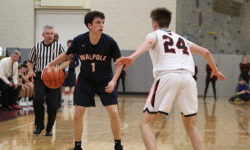[ccfic caption-text format="plaintext"]
By James Kinneen
Hometown Weekly Reporter
When Angela Kakabeeke read her book, “Whale Alert!”, to the kids of Wellesley Library on Friday, she had to stop and correct one of the lines in it. In the story, a character notes that there are about five hundred North Atlantic right whales left in the world.
But the story (which every child received a free copy of) was written around two years ago.
“Now”, she explained “there are only around four hundred of these whales left in the world.”
Worse, Kakabeeke explained that there used to be around 50,000 of them, and that it has been said there were so many off the coast of Boston harbor that “you could walk along their backs.”
So, what is happening to the whales?
They’re getting struck by boats, caught in fishing ropes and dying.
To drive home this point, Kakabeeke had the children sit in a circle, surrounded by a real fisherman’s rope, to show them what the whales are dealing with. Kakabeeke explained that while there are fishermen working to go ropeless, or devise breakaway ropes that will free an entangled whale, the fishing industry is largely using the same techniques they did hundreds of years ago - ones that are destructive to a variety of sea life, including the right whale.
Then, she had the kids wrap an elastic band around their hand, and tasked them with getting it off without using the tools right whales don’t possess - such as moving fingers, teeth (right whales have no teeth, only baleen) or clothing against which to wipe it off. The kids, of course, struggled at their task, and Kakabeeke noted that they were getting frustrated and distressed, just like the whales would be.
But, Kakabeeke didn’t just want to express the trouble the majestic animals are in - she wanted to make sure everyone knew why they’re worth saving. So, on top of her techniques to discuss the perils of the whale, she also had kids take a string and try and guess how big the whales are. To many children’s surprise, the whales are large enough to fill up nearly the entire presentation room.
One of the cool things about the whales is that the white spots on their backs, called callosities, are as unique to each whale as fingerprints are to humans. So, Kakabeeke had a craft wherein the children dipped their thumbs into white paint and used their thumbprints to create different callosities on cardboard cutouts of right whales.
Angela Kakabeeke will likely still be reading “Whale Alert!” two years from now. Hopefully, her message will get through to fishermen and lawmakers the same way it did to the kids of the Wellesley Library, and she will be able to correct the numbers in her book in a more positive way.






















